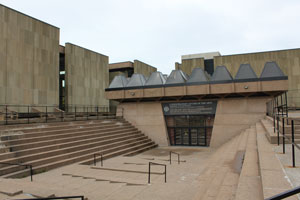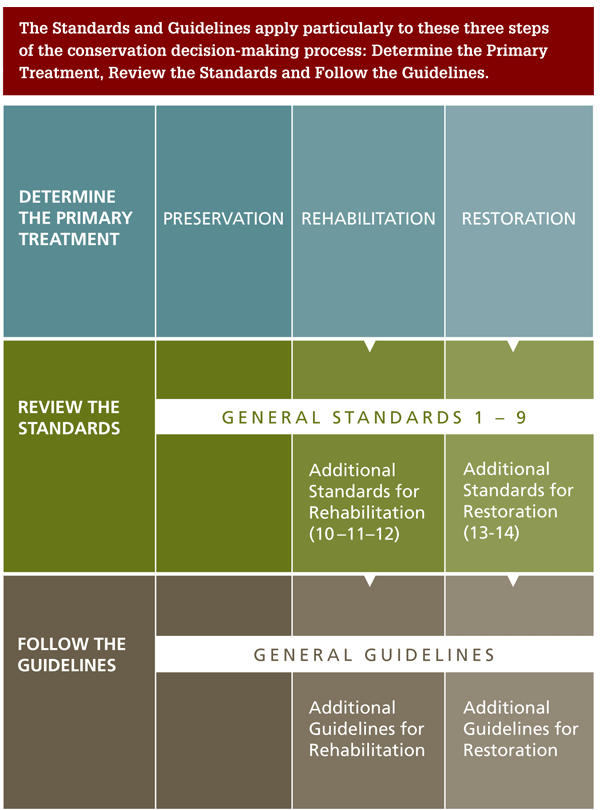The Conservation Decision-making
Process
 Conservation activities
can be seen as a sequence of actions - from understanding the
historic place, to planning for its conservation and intervening
through projects or maintenance.
Conservation activities
can be seen as a sequence of actions - from understanding the
historic place, to planning for its conservation and intervening
through projects or maintenance.
Understanding a historic place is an
essential first step to good conservation practice. This is
normally achieved through research and investigation. It is
important to know where the heritage value of the historic place
lies, along with its condition, evolution over time, and past and
current importance to its community.
Planning is the mech anism that links a comprehensive understanding of a
historic place with interventions that respect its heritage value.
Planning should consider all factors affecting the future of an
historic place, including the needs of the owners and users,
community interests, the potential for environmental impacts,
available resources and external constraints.
anism that links a comprehensive understanding of a
historic place with interventions that respect its heritage value.
Planning should consider all factors affecting the future of an
historic place, including the needs of the owners and users,
community interests, the potential for environmental impacts,
available resources and external constraints.
Intervening on a historic place,
that is, any action or process that results in a physical change to
its character-defining elements, must respect and protect its
heritage value.
These three phases can further be defined through a series
of steps:
UNDERSTANDING
- Refer to Heritage Value and Character-defining
Elements
- Investigate and Document Condition and
Changes
PLANNING
- Maintain or Select an Appropriate and Sustainable
Use
- Identify Project Requirements
- Determine the Primary Treatment
- Review the Standards
- Follow the Guidelines
INTERVENING
- Undertake the Project Work
- Carry out Regular Maintenance

The Conservation
Treatments
Conservation is the umbrella term in Canada. The
conservation treatments of preservation, rehabilitation and
restoration fall under conservation.
The Standards
The standards are based on internationally recognized
conservation principles. The 14 standards are:
General Standards (for preservation, rehabilitation and
restoration)
1. Conserve the heritage value of a historic
place. Do not remove, replace or substantially alter its intact or
repairable character-defining elements. Do not move a
part of a historic place if its current location is
a character-defining element.
2. Conserve changes to a historic place that, over
time, have become character- defining elements in
their own right.
3. Conserve heritage value by adopting an approach
calling for minimal intervention.
4. Recognize each historic place as a physical
record of its time, place and use. Do not create a false sense of
historical development by adding elements from other historic
places or other properties, or by combining features of the same
property that never coexisted.
5. Find a use for a historic place that requires
minimal or no change to its character-defining
elements. 
6. Protect and, if necessary, stabilize a historic
place until any subsequent intervention is
undertaken. Protect and preserve archaeological resources in place.
Where there is potential for disturbing archaeological resources,
take mitigation measures to limit damage and loss of
information.
7. Evaluate the existing condition ofcharacter-defining
elements to determine the
appropriate intervention needed. Use the gentlest
means possible for any intervention. Respect heritage
value when undertaking an intervention.
8. Maintain character-defining elements on an
ongoing basis. Repair character- defining elements by reinforcing
their materials using recognized conservation methods. Replace in
kind any extensively deteriorated or missing parts of
character-defining elements, where there are surviving
prototypes.
9. Make any intervention needed to
preserve character-defining elements physically and
visually compatible with the historic place and
identifiable on close inspection. Document any intervention for
future reference.
Additional Standards Relating to
Rehabilitation
10. Repair rather than replace character-defining
elements. Where character- defining elements are too severely
deteriorated to repair, and where sufficient physical evidence
exists, replace them with new elements that match the forms,
materials and detailing of sound versions of the same elements.
Where there is insufficient physical evidence, make the form,
material and detailing of the new elements compatible with the
character of the historic place.
11. Conserve the heritage value
and character-defining elements when creating any new
additions to an historic place or any related new construction.
Make the new work physically and visually compatible with,
subordinate to and distinguishable from the historic place.
12. Create any new additions or related new construction so that
the essential form and integrity of a historic place
will not be impaired if the new work is removed in the future.
Additional Standards Relating to
Restoration
13. Repair rather than replace character-defining
elements from the restoration period. Where character-defining
elements are too severely deteriorated to repair and where
sufficient physical evidence exists, replace them with new elements
that match the forms, materials and detailing of sound versions of
the same elements.
14. Replace missing features from the restoration period with
new features whose forms, materials and detailing are based on
sufficient physical, documentary and/or oral evidence.
The Guidelines
The guidelines provide practical advice for decision
making when interventions are undertaken on a historic place. The
guidelines address four types of resources as well as
materials.
- Cultural Landscapes
- Archaeological Sites
- Buildings
- Engineering Works
- Materials
KEY DEFINITIONS
|
Historic Place:
a structure, building, group of buildings, district, landscape,
archaeological site or other place in Canada that has been formally
recognized for its heritage value.
|
|
Heritage Value:
the aesthetic, historic, scientific, cultural, social or spiritual
importance or significance for past, present and future
generations. The heritage value of a historic place is embodied in
its character-defining materials, forms, location, spatial
configurations, uses and cultural associations or
meanings.
|
|
Character-defining
Element: the materials, forms,
location, spatial configurations, uses and cultural associations or
meanings that contribute to the heritage value of a historic place,
which must be retained to preserve its heritage value.
|
If you would like to know more about the Standards
and Guidelines, look at this presentation (PDF - 1.15 MB).
If you would like to know more about heritage
conservation in general, look at this document (PDF
- 77 KB).